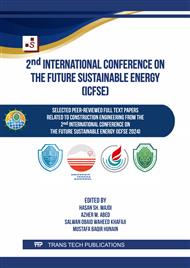[1]
Z. A. Hussain and N. M. F. Aljalawi, "Behavior of reactive powder concrete containing recycled glass powder reinforced by steel fiber," J. Mech. Behav. Mater., vol. 31, no. 1, p.233–239, 2022.
DOI: 10.1515/jmbm-2022-0025
Google Scholar
[2]
Z. K. Abbas and S. K. Abd, "Study of using of recycled brick waste (RBW) to produce environmental friendly concrete: A review," J. Eng., vol. 27, no. 11, p.1–14, 2021.
DOI: 10.31026/j.eng.2021.11.01
Google Scholar
[3]
F. M. Torgal and S. Jalali, "Resistência mecânica e durabilidade de betões modificados com polímeros," Rev. Eng. Civ. da Univ. do Minho, 2009.
Google Scholar
[4]
Z. A. Hussain and N. Aljalawi, "Effect of sustainable glass powder on the properties of reactive powder concrete with polypropylene fibers," Eng. Technol. Appl. Sci. Res., vol. 12, no. 2, p.8388–8392, 2022.
DOI: 10.48084/etasr.4750
Google Scholar
[5]
J.A.J. Al Khafaji, N.M. L. Al Maimuri, and A.H.M.H. Al Sa'adi, "The Effect of Chemical attack of some Organic Acidic Solutions to Self Compacting Concrete (SCC)," Adv. Mater. Res., vol. 587, p.67–76, 2012.
DOI: 10.4028/www.scientific.net/AMR.587.67
Google Scholar
[6]
Z. F. Muhsin and N. M. Fawzi, "Effect of Nano Calcium Carbonate on Some Properties of Reactive Powder Concrete," in IOP Conference Series: Earth and Environmental Science, IOP Publishing, 2021, p.12026.
DOI: 10.1088/1755-1315/856/1/012026
Google Scholar
[7]
H. Yazıcı, M. Y. Yardımcı, S. Aydın, and A. Ş. Karabulut, "Mechanical properties of reactive powder concrete containing mineral admixtures under different curing regimes," Constr. Build. Mater., vol. 23, no. 3, p.1223–1231, 2009.
DOI: 10.1016/j.conbuildmat.2008.08.003
Google Scholar
[8]
P. Richard and M. H. Cheyrezy, "Reactive powder concretes with high ductility and 200-800 MPa compressive strength," Spec. Publ., vol. 144, p.507–518, 1994.
DOI: 10.14359/4536
Google Scholar
[9]
Z. A. Hussain and N. M. F. Aljalawi, "Some properties of Reactive Powder Concrete Contain Recycled Glass Powder," J. Eng., vol. 28, no. 10, 2022.
DOI: 10.31026/j.eng.2022.10.04
Google Scholar
[10]
R. P. Borg, P. Hajek, and D. Fernandez Ordonez, "Sustainable concrete: materials and structures," Mater. Sci. Eng, vol. 442, p.11001, 2018.
Google Scholar
[11]
M. Adamson, A. Razmjoo, and A. Poursaee, "Durability of concrete incorporating crushed brick as coarse aggregate," Constr. Build. Mater., vol. 94, p.426–432, 2015.
DOI: 10.1016/j.conbuildmat.2015.07.056
Google Scholar
[12]
W. I. Khalil, "Some properties of modified reactive powder concrete," J. Eng. Sustain. Dev., vol. 16, no. 4, p.66–87, 2012.
Google Scholar
[13]
S. Collepardi, L. Coppola, R. Troli, and M. Collepardi, "Mechanical properties of modified reactive powder concrete," ACI Spec. Publ., vol. 173, p.1–22, 1997.
Google Scholar
[14]
A. A. Aliabdo, A.-E. M. Abd-Elmoaty, and H. H. Hassan, "Utilization of crushed clay brick in concrete industry," Alexandria Eng. J., vol. 53, no. 1, p.151–168, 2014.
DOI: 10.1016/j.aej.2013.12.003
Google Scholar
[15]
T. S. al-Attar, A. S. Ali, and B. S. Al-Numan, "The effect of coarse aggregate inclusion on the performance of reactive powder concrete exposed to oil products," in IOP Conference Series: Materials Science and Engineering, IOP Publishing, 2019, p.12044.
DOI: 10.1088/1757-899x/579/1/012044
Google Scholar
[16]
Iraqi Standard Specification No.5, "potland cement." 2019.
Google Scholar
[17]
IQ. Specification No.45, "Aggregate from Natural Sources for Concrete and Construction." 1984.
Google Scholar
[18]
IQS . No. 1703, "Used Water in Concrete," 2018.
Google Scholar
[19]
IQS No. 1703, "Properties of water used in concrete," Iraqi Specif., no. 1703, p.3000, 1992.
Google Scholar
[20]
ASTM C494– 05a, "Standard specification for chemical admixtures for concrete," no. January, p.1–10, 2005.
Google Scholar
[21]
M. A. Gawad and N. M. Fawzi, "Use of Thermostone Waste Aggregates for Internal Curing of Reactive Powder Concrete," in IOP Conference Series: Earth and Environmental Science, IOP Publishing, 2021, p.12043.
DOI: 10.1088/1755-1315/877/1/012043
Google Scholar
[22]
M. S. Amouri and N. M. Fawzi, "The effect of different curing temperatures on the properties of geopolymer reinforced with micro steel fibers," Eng. Technol. Appl. Sci. Res., vol. 12, no. 1, p.8029–8032, 2022.
DOI: 10.48084/etasr.4629
Google Scholar
[23]
Central Agency for Standardization and Quality Control, "Reference Guide No. 274,192."
Google Scholar
[24]
A. C109/C109M−16a, "Standard Test Method for Compressive Strength of Hydraulic Cement Mortars, in: Annual Book of ASTM Standards," ASTM Int. West Conshohocken, vol. i, p.109, 2021.
Google Scholar
[25]
ASTM C293/C293M −16, "Standard Test Method for Flexural Strength of Concrete (Using Simple Beam With Center-Point Loading)," vol. C78-02, no. C, p.1–4.
DOI: 10.1520/C0293
Google Scholar
[26]
M. H. Mohammed, "Shear behavior of reactive powder concrete beams with and without coarse aggregate," AUT J. Civ. Eng., vol. 2, no. 1, p.87–96, 2018.
Google Scholar



